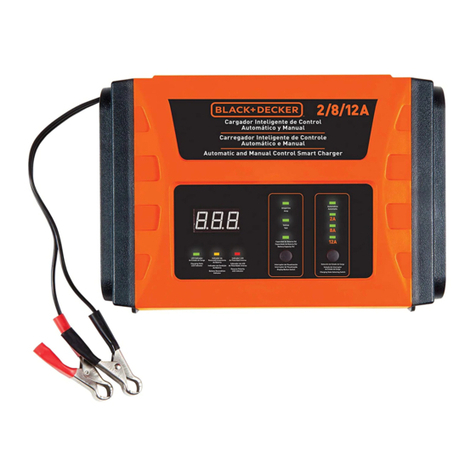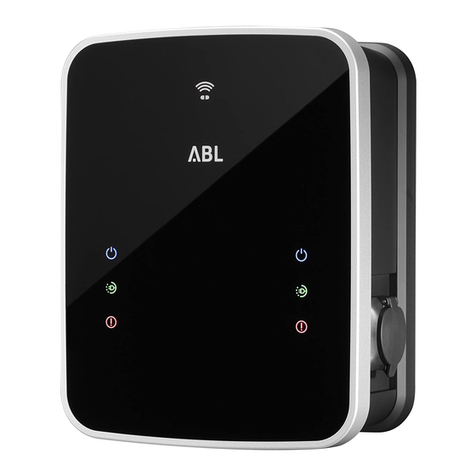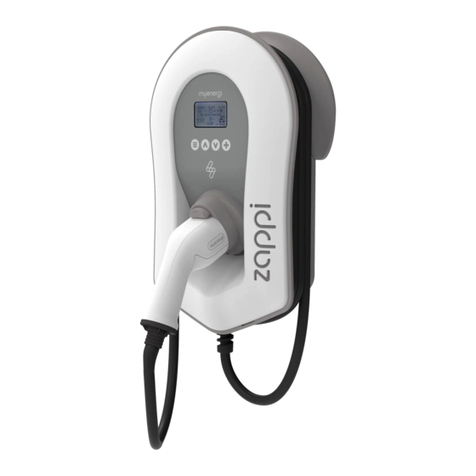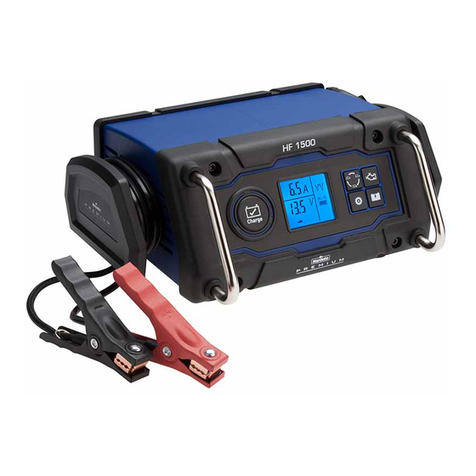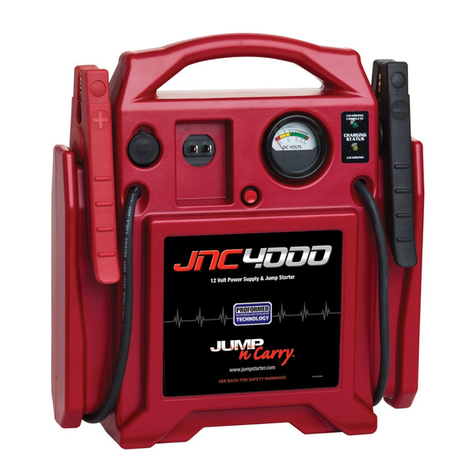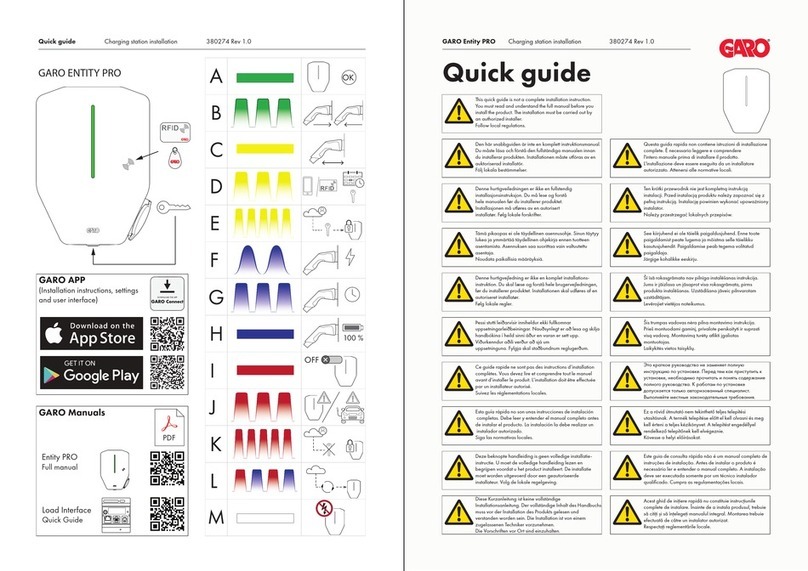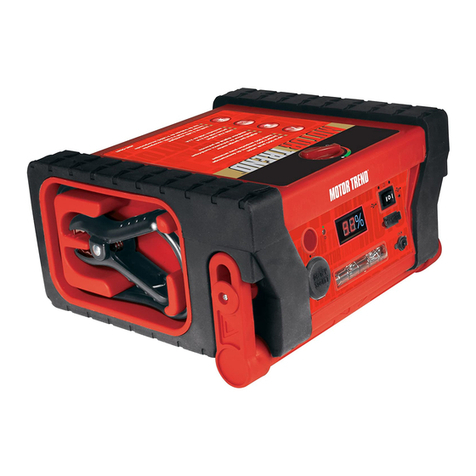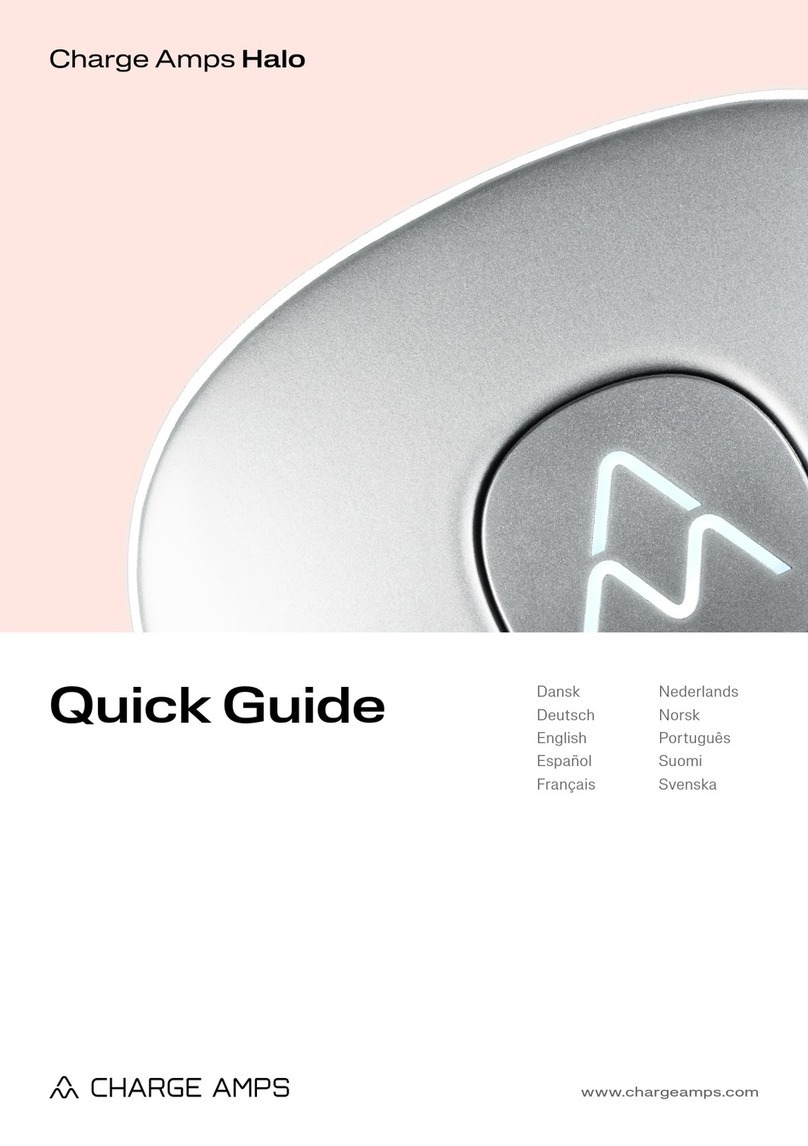EnerCharge ECC 320 Single User manual

ECC 320 Single ECC 320 Dual
Operating Manual
12/2022
Rev. 04
DC Charging Station with Integrated
AC/DC Modules and Direct Payment
ECC 320 Single/Dual

2Operating Manual: Charging Station ECC 320 ©EnerCharge GmbH
© Copyright by EnerCharge GmbH,
Subject to change.
This document is protected by copyright. It supports
the user in the safe and ecient use of the device.
Any unauthorized reproduction and / or distribution of this
manual is strictly prohibited both in whole and in part. In the
event of a violation, EnerCharge is forced to take legal action.
Please retain this operating manual for future use.
About this Document
EnerCharge GmbH
Kötschach 66 |9640 Kötschach-Mauthen |Austria |
|www.enercharge.at |www.e-charging.at

3
Operating Manual: Charging Station ECC 320 ©EnerCharge GmbH
Inhaltsverzeichnis
1. General 5
1.1 Structure of this Manual 5
1.2 Safety Symbols 6
1.3 Notes on Text Design 6
1.4 Contact Information 6
2. Product Overview 7
2.1 Product Varieties of the ECC 320 7
3. Technical Data 8
3.1 Type Plate ECC 320 9
4. Safety Notices 10
4.1 General Safety Notices 10
4.2 Intended Use 10
4.3 Operator Responsibilities 11
4.4 Qualification of Staff 12
4.5 Unauthorized Persons 13
4.6 Danger Zone 13
4.7 Basic Safety Instructions 14
4.8 Personal Protective Equipment 16
4.9 Safety Devices 16
4.10 Behavior in the Event of Danger or Accidents 19
4.11 Hazard Signs and Signage 20
4.12 Environmental Protection 20
5. Layout and Function 21
5.1 Charging Station with Direct Payment ECC 320 21
5.2 Component Description 21
5.3 Operation and Display Elements 23
5.4 Conformity with Calibration Law 37
6. Transport 39
7. Installation and Initialization 39
8. Operation 40
8.1 Opening and Closing the ECC 320 40
8.2 ECC 320 CompactCharger 41
8.3 Status LEDs of the Charger 41
8.4 Charging an e-Vehicle 42
8.5 Terminating the Charging Process 46
9. Troubleshooting 47
10. Decommissioning, Disassembly and Disposal 48
10.1 Decommissioning 48
10.2 Storage 48
10.3 Disassembly and Disposal 48
11. Attachments 49
11.1 Standards and Regulations 49
11.2 Trademark 50
11.3 Copyright 51
11.4 Customer Service 51
11.5 Legal Notice 51

4Operating Manual: Charging Station ECC 320 ©EnerCharge GmbH
List of Abbreviations
AC
A
DC
CCS/CCS Combo-2
CHAdeMO
LAN
LRM
NFC
OCPP
PVC
RFID
Type 2
WAN
>Alternating current
>Ampere
>Direct current
>Combined Charging System
>Trade name for a Japanese charging standard
>Local Area Network
>Load Regulation Management (technology by EnerCharge for the control of up to 40
external AC and DC charge points)
>Near Field Communication
>Open Charge Point Protocol - Communication standard for communication between
charging station and e-vehicle.
>Polyvinylchlorid (thermoplastic Polymer)
>Radio-Frequency Identification (Identification with electromagnetic waves)
>European plug type for charging e-vehicles with alternating current (AC).
>Wide Area Network (A computer network that, unlike LAN, extends over a very large
geographical area.)

5
Operating Manual: Charging Station ECC 320 ©EnerCharge GmbH
GENERAL
1. General
This document contains all important information on the operation, cleaning & care of the
charging station with integrated AC/DC power unit and direct payment ECC 320. It is an ori-
ginal component of the complete product provided by the manufacturer and serves to assist
in the operation of the product.
This manual is an essential operating aid for troub-
le-free and safe operation. It contains important infor-
mation on product overview, operation, care and safe
handling.
Read this manual carefully before operating the de-
vice for the first time.
This manual will help you:
>to avert user hazards
>to get to know the device
>in the optimal handling of the device
>to detect defects
>to avoid malfunctions
>to increase reliability and durability
1.1 Structure of this Manual
>Product Overview:
Brief description and overview diagram of the overall system, its function and components.
>Technical Data: Contains the technical data and type plate of the ECC 320.
>Safety Instructions:
Contains the safety instructions, provisions on liability and warranty and information on the intended use.
>Layout and Function:
Detailed description of the components and all controls of the ECC 320.
>Transport: Contains transport information for the charging station.
>Installation und Initialization:
Provides information on set-up, complete installation, and initialization.
>Operation:
Contains the operating instructions: These include the charging process, terminating the charging
process prematurely and instructions for action in the event of a fault.
>Cleaning:
Contains instructions on cleaning the ECC 320 charging station.
>Trouble Shooting:
Contains instructions for troubleshooting and a list of error messages and simple remedies.
>Decommissioning, Disassembly and Disposal:
Contains information on the proper disassembly and disposal of the device.
Please retain these operating instructions for later use
and pass on the documents if the ECC 320 charging
station is used by other persons.
Any use of the ECC 320 charging station that deviates
from these operating instructions is not permitted and
will result in the exclusion of warranty, guarantee and
liability.
All information important for the safety of the user is
marked with a corresponding symbol. This is important
information which, if ignored, may cause health conse-
quences for the user and damage to the ECC 320 char-
ging station, the vehicle or the building.

6Operating Manual: Charging Station ECC 320 ©EnerCharge GmbH
GENERAL
1.2 Safety Symbols
1.3 Notes on Text Design
1.4 Contact Information
Please take note of the following safety symbols:
Passages marked with this symbol contain important notices or particular information necessary
for successful operation. Actions marked with this symbol should be carried out as required.
This symbol in conjunction with the signal word "Warning" signies a possibly dangerous situati-
on. Disregarding this safety notice can lead to serious injury or death.
• This is a warning text with a known remedial action
This symbol in conjunction with the signal word "Danger" signies an immediate danger. Disre-
garding this safety notice can lead to serious injury or death.
• This is a warning text with a known remedial action
DANGER
WARNING
CAUTION
ATTENTION
This symbol in conjunction with the signal word "Careful!" signies a possibly dangerous situati-
on. Disregarding this safety notice can lead to minor or slight injuries.
• This is a warning text with a known remedial action
Nature, Source
Nature, Source
Nature, Source
in the 1 text body
„Quotation marks“
>List
dentifies or describes a specific component in the text body with numbered icons.
Numbered icons: Identify or describe a specific component.
Numbering: Identifies the action steps in the charging process.
Indicates text parts set off from the text body.
Indicates lists assigned to a specific section.
Indicates information for special attention.
1
1.1 1.2 1.3
2 3
G INFORMATION
>Contact / Manufacturer:
EnerCharge GmbH I Kötschach 66 I 9649 Kötschach-Mauthen I Austria I
If technical faults cannot be rectied by the customer's own means,
EnerCharge specialists can be contacted:

7
Operating Manual: Charging Station ECC 320 ©EnerCharge GmbH
PRODUCT OVERVIEW
2. Product Overview
The charging station with direct payment ECC 320 is a
charging station with integrated AC/DC power units and a
payment system with direct billing for EC, giro, ATM, credit or
debit cards. The ECC 320 charging station allows fast char-
ging of e-vehicles using CCS Combo-2 and CHAdeMO.
The maximum charging power of the CCS Combo-2 plug
is 320 kW. Operation is intuitive and customer-friendly via a
high-resolution display with a 15.6-inch diagonal.
EnerCharge offers the ECC 320 in several power levels from
20 to 240 and from 40 to 320 kilowatts. Additionally, the ECC
320 is available in single or dual versions. Dual allows simul-
taneous charging of two e-vehicles.
EnerCharge products are subject to continuous further de-
velopment and comply with all regulations and standards
applicable throughout Europe for charging e-vehicles in ac-
cordance with the IEC 61851-1, Mode 4 standard: Please also
refer to section „11.1 Standards and Regulations“ on page 46.
Visit our website at www.e-charging.at
The ECC 320 charging station by EnerCharge is an innovative and future-proof solution
for the public and industrial charging sector, which enables the charging of e-vehicles
using the DC fast charging method.
Charging Station ECC 320 Fig. 01: Charger ECC 320
Fig. 02: Configuration ECC 320
2.1 Product Varieties of the ECC 320
The ECC 320 charging station can be congured individually. The maximum charging
power, the number of charging cables, the type of charging cable, the cable manage-
ment, the charging standard (CCS and/or CHAdeMO), single or dual version and the
desired payment methods can be customized. The conguration is done by means of
an intuitive online tool. (This tool is available exclusively to EnerCharge sales partners).
>Contact / Manufacturer:
EnerCharge GmbH I Kötschach 66 I 9649 Kötschach-Mauthen I Austria I

8Operating Manual: Charging Station ECC 320 ©EnerCharge GmbH
TECHNICAL DATA
Communication Payment Module Landline, 2x GSM
Interface Modbus TCP, TCP/IP
Custom Layout Optional
Billing freely configurable pricing models: kilowatt hours
(compliant with calibration law), billing by the minute, flatrate billing,
with or without a base fee
Temperature Ranges TFT LED Display:
(1.920 x 1.080 Pixels)
Operating Temperature: -30 to +75 degrees Celsius,
Storage: - 30 to +80 degrees Celsius
Luftfeuchtigkeit (relativ): 5 to 95% (non-condensing)
Montageort /-art: interior/exterior, floor mounting on concrete foundation
Table 01: Technical Data
3. Technical Data
* S = Single: Das Laden von einem E-Fahrzeug pro Ladesäule ist möglich.
** D = Dual: Das gleichzeitige Laden von zwei E-Fahrzeugen ist möglich (Parallelladung). Die Leistungselektronik passt die Ladeleistung
automatisch an. Bsp: 1 Fahrzeug = 320 kW/1000 VDC, 2 Fahrzeuge = 2x 160 kW/1000 VDC.
*** EnerCharge bietet ungekühlte Ladekabel, welche kurzzeitig (9 min @30 Grad Celsius/20 min @0 Grad Celsius) Ladeströme bis zu 500 A gewährleisten.
Charger ECC 20 to 240 kW Single 40 to 240 kW Dual 40 to 320 kW Single 80 to 320 kW Dual
Function DC charge point with integrated AC/DC power electronics for e-vehicles with CCS charging socket
Housing Robust design (IP54/IK10)
Status Info Via 15.6 inch display, via online access
Connection Type 1x CCS Combo-2
or
1x CHAdeMO
2x CCS Combo-2
or
2x CHAdeMO
1x CCS Combo-2
or
1x CHAdeMO
2x CCS Combo-2
or
2x CHAdeMO
Charging Voltage DC DC DC DC
Max. Charging Current*** max. 450 A (CCS)
max. 200 A(CHAdeMO)
max. 450 A (CCS)
max. 200 A(CHAdeMO)
max. 450 A (CCS)
max. 200 A(CHAdeMO)
max. 450 A (CCS)
max. 200 A(CHAdeMO)
VDC max. 150 - 920 VDC 150 - 920 VDC 150 - 920 VDC 150 - 920 VDC
Integrated AC/DC
Power Modules
1 to 12 modules Type1 2 to 12 modules Type1 1 to 8 modules Type2 2 to 8 modules Type2
Charge Points 1 (Single*) 2 (Dual**) 1 (Single*) 2 (Dual**)
No. of Charging Cables 1212
Usability Easy, accessible
Payment Types for
Direct Payment
Debit and credit cards, Girocard via PIN pad, contactless payment with RFID, NFC for GooglePay
and ApplePay, memebership cards, discount cards, fleet cards, Bluetooth via EnerCharge app,
mobile payment
Display Simple, intuitive user interface, rate display, advertising insertions and provision of receipts
Charging Cable
CCS Combo-2
without Fluid Cooling
Yes
User-Friendliness «««««
Communication Standard OCPP V1.6 (Open Charge Point Protocol)
Cable Length Fixed (3.5 meters) or cable pull (4.8 meters)
Temperature Ranges Environment/Storage/Interior. Temp.: - 25 to +45 degrees Celsius
Dimensions H/W/D: 1954 / 600 / 620 mm
Weight approx. 250 kilograms + (25 kg per 20 kW power module or 40 kg per 40 kW power module)
AC/DC Power Units Type1: charge power
per power module = 20 kW Type2: charge power
per power module = 40 kW
Commissioning Remote activation by EnerCharge (no on-site appointment necessary)
Operator Portal Location-independent self-management via online access

9
Operating Manual: Charging Station ECC 320 ©EnerCharge GmbH
TECHNICAL DATA
3.1 Type Plate ECC 320
Fig. 03: ECC 320 type plate
1
2
3
4
5
6
7
Manufacturer, address
Item- / serial number
Operating voltage
Year of manufacture, weight, protection class
Rated power
Protection class
Web-address, disposal note
1
2
3
4
5
6
7

10 Operating Manual: Charging Station ECC 320 ©EnerCharge GmbH
SAFETY NOTICES
4. Safety Notices
The charging station ECC 320 is state of the art and
is operationally safe. All existing directives, standards
and all necessary safety requirements are met. The ha-
zard and safety notes in these operating instructions
are intended to ensure safe and accident-free operation.
Non-observance or violation of the instructions can lead
to residual dangers under the following circumstances:
>The device is used contrary to its intended use.
>The device is maintained and cleaned by untrained or
uninstructed personnel.
>The safety instructions in this manual are not observed.
>The device is modified or converted improperly.
>Maintenance work is not carried out in due time.
4.1 General Safety Notices
wThe Installation of the device may only be performed
by the operator or authorized specialist personnel. Ac-
ceptance must be carried out by a qualied electrical
contractor. Malfunctions of any kind that could affect
the safety of the device, connected consumers or per-
sons may only be rectied by qualied companies or
specialist personnel. Refer to the instructions: "Trans-
port, Installation and Start-Up".
Instructions for action in the event of faulty assembly
or malfunctions caused by faulty assembly: Contact
the company that carried out the assembly. If the fault
cannot be rectied, contact EnerCharge GmbH:
Siehe: „1.4 Contact Information“ on page 6.
4.2 Intended Use
The ECC 320 charging station may only be used for the intended purpose described below. The
ECC 320 charging station is used to charge the batteries of electrically powered vehicles (e-ve-
hicles) using the DC fast charging method (according to DIN EN 61851-23:2014-11). The charging
of e-vehicles is possible with CCS Combo-2 and CHAdeMO charge plugs. Failure to comply will
result in an exclusion of liability.
Misuse of the ECC 320 charging station can lead to dangerous situations. T
he consequence could be dangerous injuries.
• Refrain from any use beyond the intended use as specied.
• Strictly observe all information in these operating instructions and, if applicable, in associated documents.
• Have maintenance and servicing performed exclusively by trained maintenance personnel.
• Refrain from any modication, conversion or alteration of the design or of individual parts of the equipment
with the aim of with the aim of changing the eld of application or usability.
• Children or persons who cannot assess the dangers involved in handling the product, are prohibited from
using the charging station.
• Use at ambient temperatures lower than -25 °C or higher than 40 °C is prohibited.
• Use in the vicinity of explosive or highly ammable substances is prohibited.
• Use in a ood hazard area is prohibited.
• Use with visible damage to cables, connectors or other parts is prohibited.
• Only use adapters which comply with the standard 62196-1/3. The use of adapters that do not comply with
the 62196-1/3 standard, or misuse according to the adapter manufacturer, will void the warranty.
• The service door of the charging station may only be opened for maintenance and repair work. The key may
only be accessible to authorized persons.
WARNING Danger due to misuse of the charging station
Maintenance and repair work are part of the intended use and must be performed in compliance
with the maintenance intervals. Refer to the document "ECC 320 Maintenance Manual".
ATTENTION Maintainance and Repair

11
Operating Manual: Charging Station ECC 320 ©EnerCharge GmbH
SAFETY NOTICES
4.3 Operator Responsibilities
4.3.1 Responsibilities of the Operator
4.3.2 Briefing of the personnel
The personnel are to be instructed in accordance with the locally applicable legal
provisions and accident prevention regulations. The operator is responsible for carrying out
this instruction.
As a rule, the system is used commercially. Therefore, the operator
is subject to the statutory provisions on occupational safety.
ATTENTION
>The operator must regularly check all safety devices for functionality
and completeness. and completeness.
>The operator must ensure that the scheduled maintenance is carried out as planned.
>The operator must inform the manufacturer immediately of any damage detected.
>The operator must provide the personnel with the required protective equipment and
must and inspect, maintain and replace defective parts in accordance with applicable
regulations.
>The operator must request a new copy of the operating manual if it is in poor condition
or parts are missing.
>The operator must immediately replace all lettering, signs, or decals that are in poorly
readable condition or have been lost.
>The operator must keep the work areas and escape routes free and in perfect
condition.
>The operator must regularly check the charge plugs and charging cables of the
charging stations for damage, shut off the affected charging station if necessary and
inform the manufacturer immediately of any damage found.
>During operating hours, the operator must ensure sucient lighting in the vicinity
of the charging station.
Proper Condition: The operator is responsible for the proper condition of the equipment.
Operating instructions: The operator must inform themselves about the occupational health and safety regulations
applicable at the place of use and, in a risk assessment, identify hazards arising from the
working conditions at the place of use. They must implement the knowledge gained from
this in the form of operating instructions.
>In principle, the ECC 320 is designed for operation in extreme ambient temperatures. In
any case, it must be ensured that the maximum permissible operating temperature is
not exceeded.

12 Operating Manual: Charging Station ECC 320 ©EnerCharge GmbH
SAFETY NOTICES
4.4 Qualification of Staff
Operating Instructions:
Qualication:
Facility Manager:
Operator:
Instructor supporting
the operating personnel:
Electrician:
Specialized personnel
for installation and
commissioning:
Layperson:
Expert for inspections:
>Only persons who can be expected to observe the safety regulations and perform their
work reliably may open the charging station.
>Persons whose ability to act is influenced by drugs, alcohol, medication or similar
are not permitted.
>The personnel must comply with the occupational and activity-specific regulations in
force at the place of employment.
As a rule, persons may only perform activities for which they have the necessary
qualifications.
Is charged with the direct responsibility for the safe operation of the electrical installation at the
work site while work is being carried out. The facility manager must assess the possible effects of
the work on the electrical installation or the parts of it for which he is responsible, as well as the
effects of the electrical installation on the workplace and the people working there. This includes
the safe performance of work on or in the vicinity of this electrical system and the related safety
instructions to own employees and employees of outside companies. If necessary, some of the
obligations associated with this responsibility may be delegated to other persons.
Is responsible for the operation of the equipment after it has been handed over by the ma-
nufacturer, usually the owner.
Based on their training, knowledge and experience, is able to instruct operating personnel in
the required activities and to recognize and correct operating errors made by the operating
personnel.
Based on their training, knowledge and experience, is able to independently perform work on
electrical components for installation, commissioning and maintenance in a professional and
safe manner. The electrician knows the relevant standards and regulations.
Based on their training, knowledge and experience, is able to independently perform instal-
lation and commissioning activities in a professional and safe manner.
Does not have any of the above qualifications. Laypersons are permitted to operate
the charging station when charging e-vehicles if they have a valid driver's license.
Has in-depth technical knowledge due to their training and experience and is familiar with
the relevant occupational health and safety regulations, accident prevention regulations and
generally accepted rules of technology (e.g. BG rules, DIN standards, VDE regulations, technical
rules of other countries) to such an extent that they can assess the safe working condition of
equipment and workplaces.

13
Operating Manual: Charging Station ECC 320 ©EnerCharge GmbH
SAFETY NOTICES
Service personnel
for maintainance and
commissioning:
Designated
electrician:
Based on their training, knowledge and experience, is able to independently perform
maintenance and commissioning activities in a professional and safe manner.
Is the electrician who assumes technical and supervisory responsibility and is assigned
to do so by the contractor or operator.
4.5 Unauthorized Persons
An unauthorized person does not meet the specified personnel requirements
(see section „4.4 Qualification of Staff“ on page 12).
There are dangers that unauthorized persons cannot know about.
• Keep unauthorized persons away from the inside of the charging station.
WARNING Danger to unauthorized persons
4.6 Danger Zone
Staying in the danger zone is associated with risks that cannot be assessed
by unauthorized persons. There is a danger to life.
• Keep the service door of the charging station closed during operation.
• Always lock the service door so that no unauthorized persons can be there.
• If an unauthorized person is in the danger zone, warn the person and
stop operation immediately.
Danger to life in the danger zone
DANGER
Element Description
Immediate danger zone:
• the interior of the charging station
Table 02: Danger zone
>The danger zone corresponds to the interior of the charging station,
provided the service door is open.
>There is no danger zone in the area of the locked charging station.
Fig. 04: Danger zone

14 Operating Manual: Charging Station ECC 320 ©EnerCharge GmbH
SAFETY NOTICES
4.7 Basic Safety Instructions
4.7.1 Hazard due to electrical components
Danger to life due
to electric current!
Danger due to
electric arc!
Danger of short circuit in
case of ooding!
Touching live parts can result in serious injury or death:
>Only qualified electricians may carry out work on electrical systems.
>Observe five safety rules according to the DIN VDE 0105 series of standards.
>Before carrying out maintenance, cleaning and repair work, switch off the power
supply, check that it is de-energized and secure it against being switched on again.
>Never bridge fuse switches or put them out of operation.
>If the insulation is damaged, switch off the power supply immediately and
arrange for repair.
>Keep moisture away from live parts.
Inside the charging station, voltage flashovers can cause an electric arc and hot arc
gases and result in life-threatening injury or death.
>Never remove arc-resistant covers from live parts.
>Keep moisture away from live parts.
If the system is flooded, short circuits may occur. There is a risk of property damage.
>Stop operations when severe weather with a risk of flooding is imminent.
>Before returning to service after flooding, have all components checked by
EnerCharge Service technicians.

15
Operating Manual: Charging Station ECC 320 ©EnerCharge GmbH
SAFETY NOTICES
4.7.2 Thermal Hazards
Fire hazard! Work waste lying around, unremoved residues of oils and greases, etc. can promote the
development and spread of fire:
>Keep the surroundings of the charging station ECC 320 tidy and clean.
>Do not store flammable materials in the vicinity.
>Keep the intake and exhaust openings of the ECC 320 charging station free of objects
(e.g. small objects, plants, snow) so that the air flow is not impaired.
>If there are visible defects in the wiring, have them repaired or replaced immediately by
a qualified electrician due to the risk of overheating.
4.7.3 Other Hazards
Danger due to missing
safety decals!
Danger due to faulty
spare parts and
accessories!
Danger due to blocked
escape routes!
Danger due to
improper operation!
The absence of safety decals can lead to hazards.
>Check the safety decals for damage and completeness.
>Do not remove the safety decals.
>Replace damaged or lost safety decals.
Faulty spare parts can lead to hazards.
>Only use original spare parts and accessories approved by the manufacturer.
The accessible areas in the vicinity of the charging station serve as escape routes. If escape
routes are blocked, serious injuries can occur in hazardous situations.
>Keep the areas in the vicinity of the charging station free of objects.
>Always keep the doors of the ECC 320 charging station closed and locked.
Improper operation of the controls inside the charging station by insufficiently qualified
personnel can lead to hazardous situations and property damage.
>Switching operations inside the ECC 320 charging station may only be
performed by trained personnel.
>In case of insufficient qualification of the personnel to perform the activities,
contact the manufacturer.

16 Operating Manual: Charging Station ECC 320 ©EnerCharge GmbH
SAFETY NOTICES
4.8 Personal Protective Equipment
Recommended
Protective Equipment
The personal protective equipment (PPE) is not part of the scope of delivery. The operator is
responsible for the presence, inspection and correct use of the PPE.
EnerCharge recommends the following protective equipment when performing maintenance
work inside the ECC 320 charging station:
>Safety glasses: When performing maintenance inside the ECC 320 charging
station, ejected dirt particles from spinning fan wheels can injure the eyes.
4.9 Safety Devices
Risk of injury when
working inside the
charging station
Safety for persons working inside the ECC 320 charging station is only guaranteed when the
safety devices are functioning.
>Before starting work, check safety equipment for signs of malfunctions or defects.
>In case of malfunctions or defects of safety devices, inform the service personnel.
>Never override safety equipment.
4.9.1 Line/Fault-Current Circuit Breaker AC Supply
Switching the supply
voltage (AC) on and off
Location
The circuit breaker is used to switch the supply voltage of the
ECC 320 charging station (AC) on or off.
The circuit breaker is located in the center of the ECC 320
charging station. For the exact location, see the "Maintenance
instructions" document.
Fig. 05: Line/fault-cur-
rent circuit breaker and
load-break switch
ON
OFF

17
Operating Manual: Charging Station ECC 320 ©EnerCharge GmbH
SAFETY NOTICES
4.9.2 Contact Hazard Protection
Protection against
direct contact with
live parts
Live parts inside the ECC 320 charging station are shut off by
means of screwed PVC contact protection. This prevents contact with
the live parts.
>Contact hazard protection in the ECC 320 charging station corres-
ponds to IP1x.
4.9.3 Smoke Detector
Smoke detector with
automatic shutdown
Location
The charging station has a smoke detector. If smoke develops, the charging
station is automatically switched off. At the same time, the ventilation is
switched off.
The smoke detector is located in the upper area inside the charging station.
For the exact location, see the "Maintenance instructions" document.
4.9.4 Lighting
Exterior lighting
Charging Station
The operator is responsible for ensuring adequate lighting of the vehicle parking
areas in front of the ECC 320 charging station and the area surrounding the system.
At the charging station, the display lighting ensures sufficient ambient brightness.
The control elements have LED lighting.
4.9.5 Service Door
Side service door
of charging station
Contact-switch
at service door
Location
The side service door serves to protect against hazards inside the charging stati-
on and prevents access by unauthorized persons. The service door is secured by a
lock and can only be unlocked with the appropriate key.
The service door of the ECC 320 charging station has a safety door limit switch.
The AC supply remains live when the service door is open. For deactivation of the
AC supply, see the "Maintenance instructions" document.
See: „8.1 Opening and Closing the ECC 320“ on page 40.

18 Operating Manual: Charging Station ECC 320 ©EnerCharge GmbH
SAFETY NOTICES
4.9.6 Overload and Overtemperature Protection
Overload/ Overtemp.
protection of
charging station
The charging current is limited in order to exclude overheating of the
charging cable due to overload.
The charge plugs and charging cables of the CCS Combo-2 type have a
temperature monitor that reduces the charging current if there is a risk
of overheating.
The simultaneous use of both charging cables of a charging station, which
could lead to an overload, is excluded by an electromechanical fuse.
The number of plug-in cycles of the charge plug is counted by a sensor (CCS
Combo 2 500 A) or by a software (CCS Combo 2 200 A and CHAdeMO). If the
number of plug-in cycles specified by the manufacturer of the charge plug is
reached, the contacts of the charge plug or the charge plug must be replaced
to prevent overheating.
4.9.7 Mains Safety Circuit
4.9.8 Locking system of the charge plugs (CCS Combo-2 and CHAdeMO)
Locking system
of charge plug
CCS Combo-2
Locking system
of charge plug
CHAdeMO
The CCS Combo-2 charge plug has a locking system to prevent the plug connection
between the ECC 320 charging station and the electric vehicle from being pulled under
voltage. The charge plug is locked by the vehicle before charging begins. Unlocking after
the charging process also takes place on the vehicle side.
At the end of the charging process, the CCS Combo-2 charge plug must be correctly
placed in the holder on the ECC 320 charging station to complete the charging process.
The CHAdeMO charge plug has a locking system to prevent the plug connection bet-
ween the charging station and the electric vehicle from being pulled under voltage. The
charge plug is locked by the charging station before charging begins. At the end of the
charging process, the CHAdeMO charge plug is unlocked by pressing the Eject button
(siehe „5.3 Operation and Display Elements“ on page 23).
At the end of the charging process, the CHAdeMO charge plug must be correctly placed
in the holder on the DC FastCharger charging station to complete the charging process.
Interruption of the
charging current in the
event of a malfunction
or danger
The mains safety circuit is used to put the ECC320 charging station into a safe state in the
event of danger or malfunction. The grid safety circuit is routed from the low-voltage cont-
ainer to the ECC320 charging station. If a fault occurs in one of these components, the grid
safety circuit opens and interrupts the voltage supply to the ECC320 charging station.
The following circumstances lead to an interruption of the grid safety circuit:
>A smoke switch in the charging station or low-voltage container reports
smoke development.
>There is a fault in the controller or the charge controller in the ECC320
charging station.

19
Operating Manual: Charging Station ECC 320 ©EnerCharge GmbH
SAFETY NOTICES
4.10 Behavior in the Event of Danger or Accidents
Preventive
Measures
>Always be prepared for accidents or fire!
>Material für Erste-Hilfe-Maßnahmen (Verbandskasten, Decken usw.) und
Feuerlöscher griffbereit aufbewahren und Aufbewahrungsort deutlich
kennzeichnen.
>Keep first aid materials (first aid kit, blankets, etc.) and fire extinguishers
within easy reach and clearly mark where they are kept.
>Train personnel in how to behave in accidents and hazardous situations
and familiarize them with accident reporting, first aid and rescue equip-
ment.
>Keep access routes clear for emergency vehicles.
In Case
of Fire
>Alert fire department.
>Rescue injured persons from danger zone and provide first aid.
>Fight the fire with a suitable fire extinguisher; follow the operating ins-
tructions for the fire extinguisher. Only attempt to extinguish the fire if
your own safety and a safe escape route are guaranteed.
>If the fire cannot be extinguished immediately, do not make any further
attempts to extinguish it. Evacuate the danger area.
>Clear access routes for emergency vehicles.
In Case of
Accidents
>Make sure that all supply lines are de-energized.
>Rescue persons from the danger zone.
>Initiate first-aid measures.
>Alert emergency services.
>Inform the person responsible at the place of use.
>Clear access routes for emergency vehicles.

20 Operating Manual: Charging Station ECC 320 ©EnerCharge GmbH
SAFETY NOTICES
4.11 Hazard Signs and Signage
In the interior of
the charging station
This section provides an overview of hazard signs and signage
and their location.
Table 03: Signage inside the charger
4.12 Environmental Protection
Operating uids
Wash water
Electrical components
Operating fluids such as hydraulic fluids and lubricants (greases and oils)
contain toxic substances. These must not be released into the environment.
Disposal must be carried out by a specialist disposal company.
Contain contaminated wash water and have it disposed of by a specialist
disposal company.
Electrical components (e.g. circuit boards, cables, switches, lamps) can contain
both valuable recyclable raw materials and toxic substances. They must be
separated from other waste materials and handed in at authorized collection
points.
Signage Description Location
5 Safety Rules On the protective
cover inside the
charging station
Attention electrical
voltage
Inside of the
service door
Observe operating
instructions
Inside of the
service door
Other manuals for ECC 320 Single
1
This manual suits for next models
1
Table of contents
Other EnerCharge Automobile Batteries Charger manuals
Popular Automobile Batteries Charger manuals by other brands
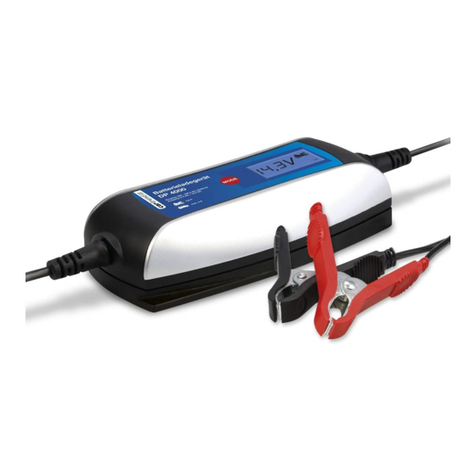
Cartrend
Cartrend DP 4000 Instructions for use
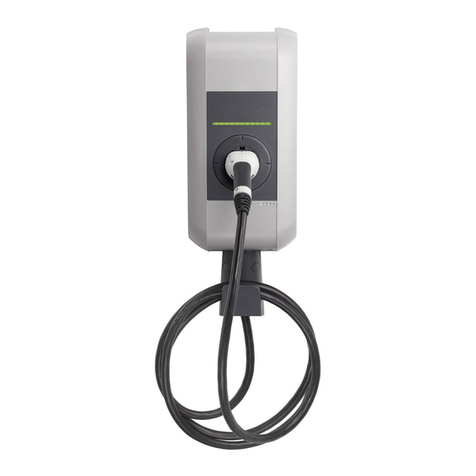
Keba
Keba KeContact P20 installation manual
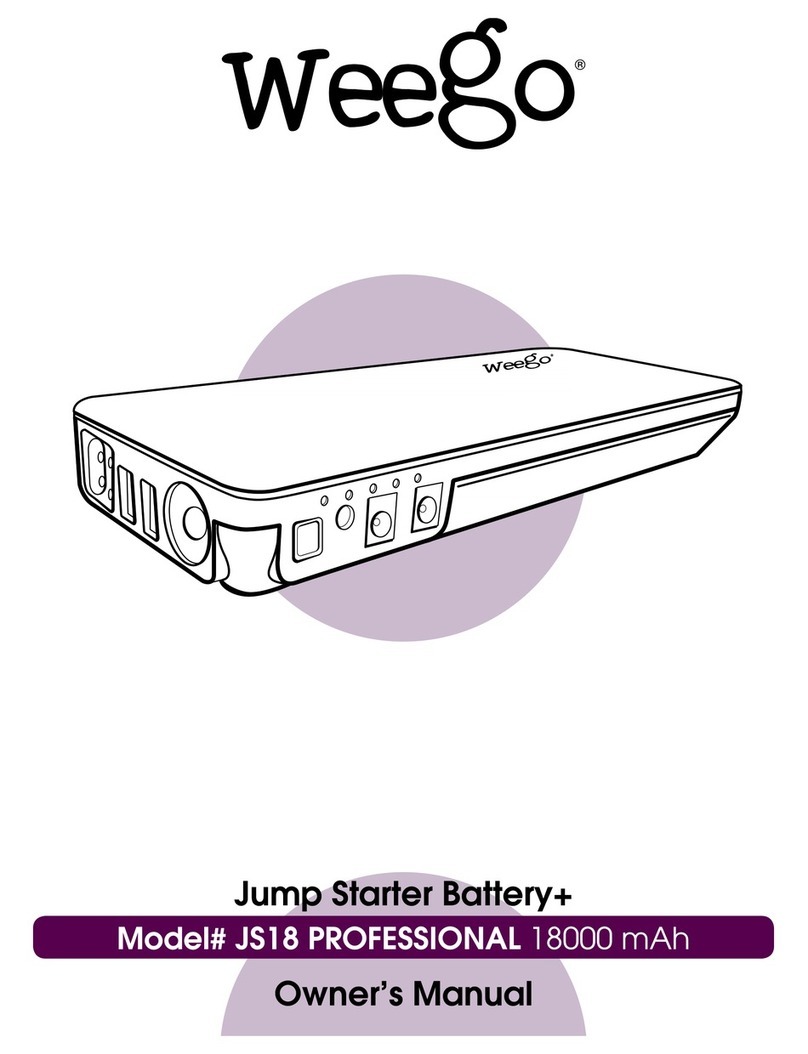
Weego
Weego JS18 Professional owner's manual
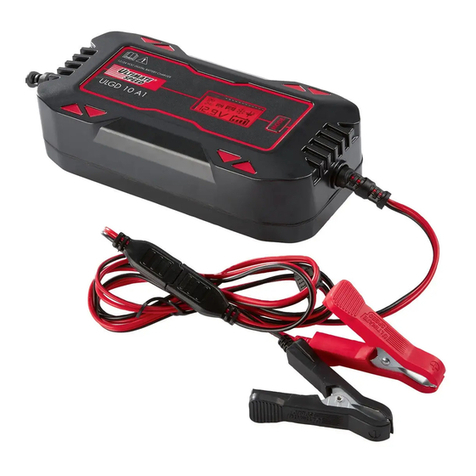
ULTIMATE SPEED
ULTIMATE SPEED ULGD 10 A1 Translation of the original instructions

EVBox
EVBox Iqon Installation and commissioning manual
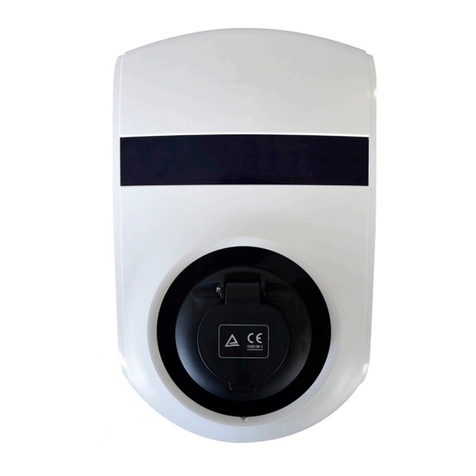
Vynco
Vynco E1V2 User's operating manual


